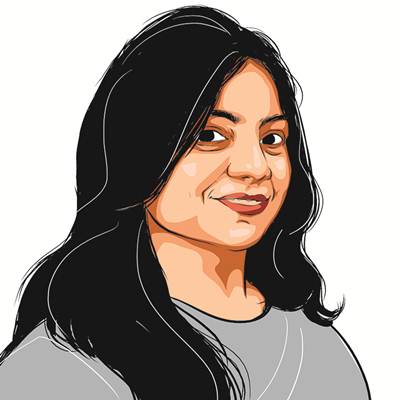Opinion Busting myths and half-truths about Poshan Tracker
As the Poshan Tracker evolves, the focus must now shift to countering myths with accurate information, working on usability testing based on feedback from the ground, streamlining the service delivery workflows to reduce time burdens and investing in digital literacy of Anganwadi workers.
 The Poshan Tracker, launched in 2021 by the Ministry of Women and Child Development, is among the world’s largest government-funded nutrition monitoring systems. (Ilustration by Mithun)
The Poshan Tracker, launched in 2021 by the Ministry of Women and Child Development, is among the world’s largest government-funded nutrition monitoring systems. (Ilustration by Mithun) The Poshan Tracker has been in the public conversation, and not always for the right reasons. Myths and half-truths about e-KYC and the Facial Recognition System (FRS) have led to confusion among citizens and Anganwadi workers alike.
Such misconceptions, though often rooted in limited understanding or early teething issues, risk overshadowing the intent of these digital reforms — to build a system that is more transparent and accountable.
The Poshan Tracker, launched in 2021 by the Ministry of Women and Child Development, is among the world’s largest government-funded nutrition monitoring systems. It connects more than 1.4 million Anganwadi Centres, recording service delivery and monitoring the nutritional status of over 88 million women, children and adolescent girls across target geographies.
With a system of this magnitude, ensuring that the ration reaches its rightful recipient requires precision and trust. Despite sustained efforts by the government, challenges such as duplicate or “ghost” beneficiaries, diversion and leakage of food rations, and occasional shortfalls in quantity or quality have persisted. To overcome these gaps, the Poshan Tracker introduced e-KYC and FRS.
Simply put, e-KYC means digital verification of a beneficiary’s identity through their Aadhaar. The Anganwadi worker enters the Aadhaar number, an OTP is sent to the registered mobile number, and once verified, the beneficiary is marked as e-KYC verified on the Poshan Tracker.
The Facial Recognition System (FRS) ensures that the right person receives the food ration. As the take-home tation (THR) is distributed every month, the Anganwadi worker logs into the Poshan Tracker app, selects the beneficiary, and captures a live photo. The app automatically compares this photo with the facial image captured during the time of registration and e-KYC authentication. When the match is confirmed, the Anganwadi worker hands over the ration, and the Poshan Tracker records it digitally as proof of delivery.
With e-KYC and FRS, the system now enables real-time tracking of who received what, when and where. Like any reform, digital innovation comes with its share of doubts and misconceptions.
Here’s a closer look at some common myths — and the facts behind them.
One, that e-KYC needs to be done every month. The fact is that it is a one-time verification process. Once verified, the beneficiary is permanently marked as “e-KYC verified”. Myth two, even small children must undergo facial recognition. The Poshan Tracker does not undertake facial authentication of children under six years for delivery of THR. It verifies the child’s identity through the parent or guardian, usually the mother. Myth three is that FRS for THR distribution cannot function offline. There are also some concerns about the lack of internet connectivity in rural areas. Face matching works in both online and offline modes, with the offline option specifically developed for low-connectivity areas.
Four, personal data and photographs are stored locally. While citizen concerns around data security are valid, the Ministry has affirmed that robust data protocols have been instituted. All verification requests and data are processed through encrypted channels, no photographs or personal identifiers are allowed to be stored locally, and the backend database remains fully secured.
Five, every beneficiary needs a smartphone for facial authentication to receive their ration. Beneficiaries are not required to own a smartphone for facial authentication. The Anganwadi worker conducts a one-time Aadhaar verification using an OTP sent to the beneficiary’s registered mobile number. Thereafter, during monthly ration distribution, the worker takes a photo of the beneficiary through the Poshan Tracker app to confirm that the ration has been delivered to the right person.
The numbers tell a powerful story. As of August, nearly 3.69 crore THR beneficiaries — out of 4.9 crore registered, representing about 75 per cent of the target base — had completed e-KYC and facial authentication. This reflects India’s remarkable readiness to embrace digital tools at scale and its growing confidence in technology-driven public service delivery.
As the Poshan Tracker evolves, the focus must now shift to countering myths with accurate information, working on usability testing based on feedback from the ground, streamlining the service delivery workflows to reduce time burdens and investing in digital literacy of Anganwadi workers.
fcolumn





